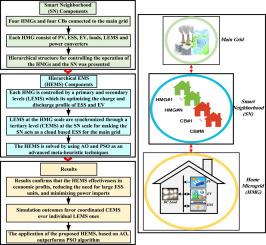多并网家庭微电网协同运行的分层能量管理系统
IF 5.9
Q2 ENERGY & FUELS
引用次数: 0
摘要
由多个家庭微电网(hmg)组成的智能社区(SN)可以为最终用户提供经济高效的电力,同时通过辅助服务支持主电网。可再生能源(RESs)、储能系统(ess)和电动汽车(EV)的整合带来了动态挑战,特别是在不同的电动汽车充电行为下。为了解决这些挑战,本研究开发了一种分层能量管理系统(HEMS),该系统被制定为一个优化问题,并使用Aquila优化器(AO)来解决。拟议的HEMS使SN能够作为基于云的储能系统(cloud-based ESS)运行,最大限度地减少从主电网进口的能源,同时最大限度地提高本地自我消耗和收入。AO的性能在两种控制体系结构下以粒子群优化(PSO)算法为基准进行基准测试:(i)单独操作,其中每个本地EMS (LEMS)优化其自己的HMG; (ii)协调操作,其中中央EMS (CEMS)同步所有HMG,使SN能够作为基于云的ESS共同发挥作用。仿真结果表明,在协调CEMS框架下,AO具有优越的性能。对于标准运行,AO将主电网进口量从61.66千瓦时减少到30.62千瓦时,在ess和电动汽车中保持更高的SOC水平(高达90%),提供更高的总收入(44.662英镑对22.907英镑),并最大限度地减少累积误差(10.2%对18.7%)。在不同的电动汽车充电行为下,AO表现出强大的适应性,实现了更低的电网输入(40.43 kWh vs 49.97 kWh),在ess和电动汽车中保持更高的SOC(高达88.5%),提供更高的总收入(15.311英镑vs 12.101英镑,+26.5%),并将累积误差从158.19降低到146.25(改善7.6%)。这些结果证实,基于ao的HEMS有效地协调分布式能源,使SN能够作为可靠的基于云的ESS。它提高了能源效率、经济回报和电网支持,同时在动态电动汽车充电条件下保持弹性,为未来的SN能源管理提供了可扩展和自适应的框架。本文章由计算机程序翻译,如有差异,请以英文原文为准。

Hierarchical energy management system for coordinated operation of multiple grid-tied home microgrids
A smart neighborhood (SN) comprising multiple home microgrids (HMGs) can provide cost-efficient electricity to end-users while supporting the main grid through ancillary services. The integration of renewable energy sources (RESs), energy storage systems (ESSs), and electric vehicles (EVs) introduces dynamic challenges, particularly under varying EV charging behaviors. To address these challenges, this study develops a hierarchical energy management system (HEMS) formulated as an optimization problem and solved using the Aquila optimizer (AO). The proposed HEMS enables the SN to operate as a cloud-based energy storage system (cloud-based ESS), minimizing energy imports from the main grid while maximizing local self-consumption and revenue. The performance of AO is benchmarked against the Particle Swarm Optimization (PSO) algorithm under two control architectures: (i) individual operation, where each local EMS (LEMS) optimizes its own HMG, and (ii) coordinated operation, where a central EMS (CEMS) synchronizes all HMGs, enabling the SN to function collectively as a cloud-based ESS. Simulation results highlight the superior performance of AO under the coordinated CEMS framework. For standard operation, AO reduces main grid imports to 30.62 kWh compared to 61.66 kWh, maintains higher SOC levels across ESSs and EVs (up to 90%), delivers greater total revenue (£44.662 vs. £22.907), and minimizes cumulative error (10.2% vs. 18.7%). Under different EV charging behaviors, AO demonstrates robust adaptability, achieving lower grid imports (40.43 kWh vs. 49.97 kWh), maintaining higher SOC across ESSs and EVs (up to 88.5%), delivering greater total revenue (£15.311 vs. £12.101, +26.5%), and reducing cumulative error from 158.19 to 146.25 (7.6% improvement). These results confirm that the AO-based HEMS efficiently coordinates distributed energy resources, enabling the SN to function as a reliable cloud-based ESS. It improves energy efficiency, economic returns, and grid support while maintaining resilience under dynamic EV charging conditions, providing a scalable and adaptive framework for future SN energy management.
求助全文
通过发布文献求助,成功后即可免费获取论文全文。
去求助
来源期刊

Renewable Energy Focus
Renewable Energy, Sustainability and the Environment
CiteScore
7.10
自引率
8.30%
发文量
0
审稿时长
48 days
 求助内容:
求助内容: 应助结果提醒方式:
应助结果提醒方式:


